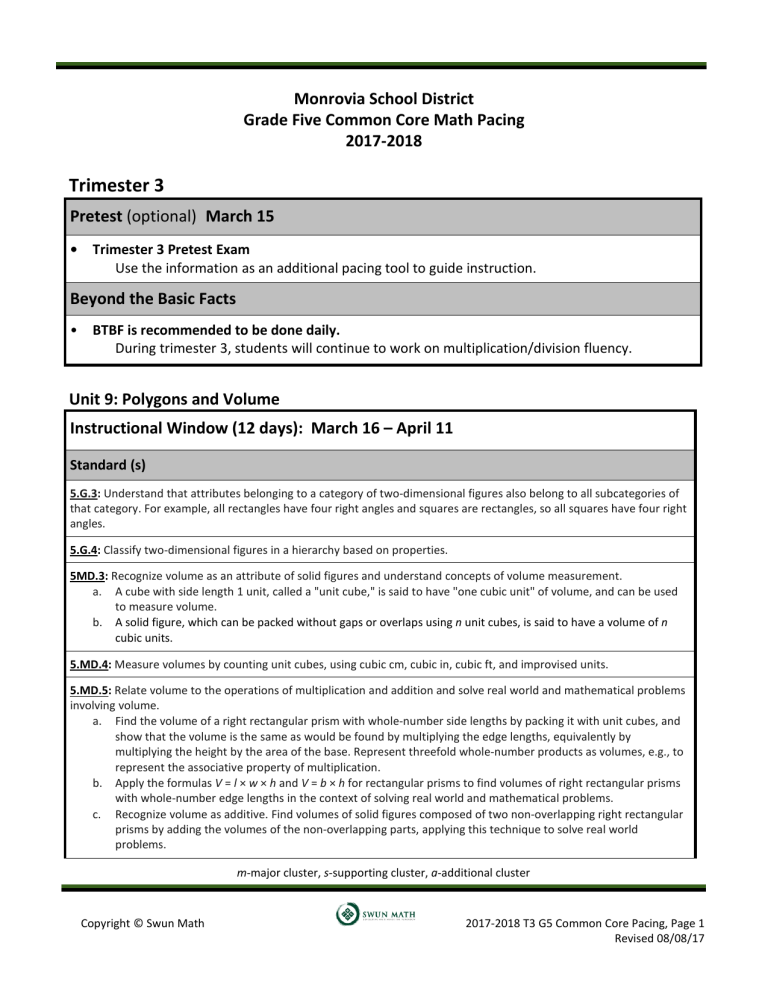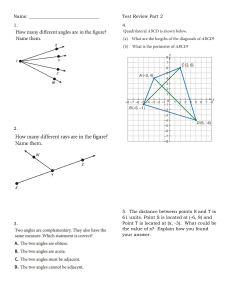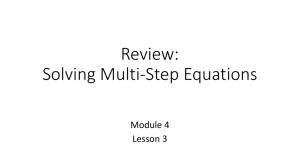
Monrovia School District Grade Five Common Core Math Pacing 2017-2018 Trimester 3 Pretest (optional) March 15 • Trimester 3 Pretest Exam Use the information as an additional pacing tool to guide instruction. Beyond the Basic Facts • BTBF is recommended to be done daily. During trimester 3, students will continue to work on multiplication/division fluency. Unit 9: Polygons and Volume Instructional Window (12 days): March 16 – April 11 Standard (s) 5.G.3: Understand that attributes belonging to a category of two-dimensional figures also belong to all subcategories of that category. For example, all rectangles have four right angles and squares are rectangles, so all squares have four right angles. 5.G.4: Classify two-dimensional figures in a hierarchy based on properties. 5MD.3: Recognize volume as an attribute of solid figures and understand concepts of volume measurement. a. A cube with side length 1 unit, called a "unit cube," is said to have "one cubic unit" of volume, and can be used to measure volume. b. A solid figure, which can be packed without gaps or overlaps using n unit cubes, is said to have a volume of n cubic units. 5.MD.4: Measure volumes by counting unit cubes, using cubic cm, cubic in, cubic ft, and improvised units. 5.MD.5: Relate volume to the operations of multiplication and addition and solve real world and mathematical problems involving volume. a. Find the volume of a right rectangular prism with whole-number side lengths by packing it with unit cubes, and show that the volume is the same as would be found by multiplying the edge lengths, equivalently by multiplying the height by the area of the base. Represent threefold whole-number products as volumes, e.g., to represent the associative property of multiplication. b. Apply the formulas V = l × w × h and V = b × h for rectangular prisms to find volumes of right rectangular prisms with whole-number edge lengths in the context of solving real world and mathematical problems. c. Recognize volume as additive. Find volumes of solid figures composed of two non-overlapping right rectangular prisms by adding the volumes of the non-overlapping parts, applying this technique to solve real world problems. m-major cluster, s-supporting cluster, a-additional cluster Copyright © Swun Math 2017-2018 T3 G5 Common Core Pacing, Page 1 Revised 08/08/17 T.E. pg. # Lesson Topic * = optional lesson (c) = combine lessons Standard Lesson Focus 2 Lesson 1* Classifying Polygons (a) 5.G.3, 4 C 22 Lesson 2 Classifying Polygons (a) 5.G.3, 4 C 30 Lesson 3 Classifying Polygons (a) 5.G.3, 4 P 42 Lesson 4 Finding Volume with Unit Cubes (m) 5.MD.3b, 4 C 52 Lesson 5* Finding Volume with Unit Cubes (m) 5.MD.3b, 4 P 64 Lesson 6 (c) Finding Volume Using the Area of the Base (m) 5.MD.3b, 4 C 72 Lesson 7 (c) Finding Volume Using the Area of the Base (m) 5.MD.3b, 4 P 84 Lesson 8* Finding Volume Using an Algorithm (m) 5.MD.5b C 94 Lesson 9 Finding Volume Using an Algorithm (m) 5.MD.5b P 106 Lesson 10 Finding the Volume of Three-Dimensional Figures (m) 5.MD.5c C 116 Lesson 11 Finding the Volume of Three-Dimensional Figures (m) 5.MD.5c P 128 Lesson 12 Polygons and Volume (m) 5.MD.5a-c, 4 MT Suggested Unit 9 Assessment Date – April 12 & 13 Unit 10: Graphing Instructional Window (17 days): April 16 – May 8 Standard (s) 5.G.1: Use a pair of perpendicular number lines, called axes, to define a coordinate system, with the intersection of the lines (the origin) arranged to coincide with the 0 on each line and a given point in the plane located by using an ordered pair of numbers, called its coordinates. Understand that the first number indicates how far to travel from the origin in the direction of one axis, and the second number indicates how far to travel in the direction of the second axis, with the m-major cluster, s-supporting cluster, a-additional cluster Copyright © Swun Math 2017-2018 T3 G5 Common Core Pacing, Page 2 Revised 08/08/17 convention that the names of the two axes and the coordinates correspond (e.g., x-axis and x-coordinate, y-axis and ycoordinate). 5.G.2: Represent real-world and mathematical problems by graphing points in the first quadrant of the coordinate plane, and interpret coordinate values of points in the context of the situation. 5.OA.3: Generate two numerical patterns using two given rules. Identify apparent relationships between corresponding terms. Form ordered pairs consisting of corresponding terms from the two patterns, and graph the ordered pairs on a coordinate plane. For example, given the rule "Add 3" and the starting number 0, and given the rule "Add 6" and the starting number 0, generate terms in the resulting sequences, and observe that the terms in one sequence are twice the corresponding terms in the other sequence. Explain informally why this is so. T.E. pg. # Lesson Topic * = optional lesson (c) = combine lessons Standard Lesson Focus 138 Lesson 1 Plotting Ordered Pairs (a) 5.G.1 C 146 Lesson 2 Plotting Ordered Pairs: Scaled Coordinate Plane 5.G.1 (a) C 156 Lesson 3 Plotting Ordered Pairs: Scaled Coordinate Plane(a) 5.G.1 P 170 Lesson 4 (c) Graphing Shapes (a) 5.G.1 C 186 Lesson 5 (c) Graphing Shapes (a) 5.G.1 P 200 Lesson 6 (c) Finding the Location of an Ending Point Given a Starting Point (a) 5.G.1, 2 C 208 Lesson 7 (c) Finding the Location of an Ending Point Given a Starting Point (a) 5.G.1, 2 P 220 Lesson 8 (c) Locating a Point on the Coordinate Grid Using Cardinal Directions (a) 5.G.1, 2 C 228 Lesson 9 (c) Locating a Point on the Coordinate Grid Using Cardinal Directions (a) 5.G.1, 2 P 240 Lesson 10 Coordinate Plane (a) 5.G.1, 2 MT 252 Lesson 11 Identifying Relationships between Numerical Patterns (a) 5.OA.3 C 262 Lesson 12 Identifying Relationships between Numerical Patterns (a) 5.OA.3 P m-major cluster, s-supporting cluster, a-additional cluster Copyright © Swun Math 2017-2018 T3 G5 Common Core Pacing, Page 3 Revised 08/08/17 274 Lesson 13* Graphing Patterns (a) 5.OA.3 C 292 Lesson 14 Graphing Patterns (a) 5.OA.3 P 320 Lesson 15 Graph & Analyze Real World Data (a) 5.G.2, 5.OA.3 C 334 Lesson 16 Graph & Analyze Real World Data (a) 5.G.2, 5.OA.3 P 358 Lesson 17 Representing Numerical Patterns (a) 5.G.1, 2 5.OA.3 MT Suggested Unit 10 Assessment Date – May 9 & 10 Unit 11: Measurement and Data Instructional Window (11 days): May 11 – May 24 Standard (s) 5.MD.1: Convert among different-sized standard measurement units within a given measurement system (e.g., convert 5 cm to 0.05 m), and use these conversions in solving multi-step, real-world problems. 5.MD.2: Make a line plot to display a data set of measurements in fractions of a unit (1/2, 1/4, 1/8). Use operations on fractions for this grade to solve problems involving information presented in line plots. For example, given different measurements of liquid in identical beakers, find the amount of liquid each beaker would contain if the total amount in all the beakers were redistributed equally. T.E. pg. # Lesson Topic * = optional lesson (c) = combine lessons Standard Lesson Focus 370 Lesson 1 Length: Multi-Step Word Problems (a) 5.MD.1 C 380 Lesson 2 Length: Multi-Step Word Problems (a) 5.MD.1 P 392 Lesson 3 Weight: Multi-Step Word Problems (a) 5.MD.1 C 400 Lesson 4 Weight: Multi-Step Word Problems (a) 5.MD.1 P 412 Lesson 5 Volume: Multi-Step Word Problems (a) 5.MD.1 C 422 Lesson 6 Volume: Multi-Step Word Problems (a) 5.MD.1 P 436 Lesson 7 Measurement: Multi-Step word problems (a) 5.MD.1 MT m-major cluster, s-supporting cluster, a-additional cluster Copyright © Swun Math 2017-2018 T3 G5 Common Core Pacing, Page 4 Revised 08/08/17 444 Lesson 8* Line Plots: Multi-Step Word Problems (a) 5.MD.2 C 454 Lesson 9* Line Plots: Multi-Step Word Problems (a) 5.MD.2 P 468 Lesson 10 Line Plots: Multi-Step Word Problems with Division (a) 5.MD.2 C 478 Lesson 11 Line Plots: Multi-Step Word Problems with Division (a) 5.MD.2 P 496 Lesson 12 Line Plots 5.MD.2 MT Suggested OPTIONAL Unit 11 Assessment Date – May 25 & 29 End of Trimester 3 Assessments Suggested Review Day for Trimester 3 Benchmark Date – May 30 Suggested Trimester 3 Cumulative Benchmark Date – May 31 & June 1 Performance Task – June 4 & 5 m-major cluster, s-supporting cluster, a-additional cluster Copyright © Swun Math 2017-2018 T3 G5 Common Core Pacing, Page 5 Revised 08/08/17


